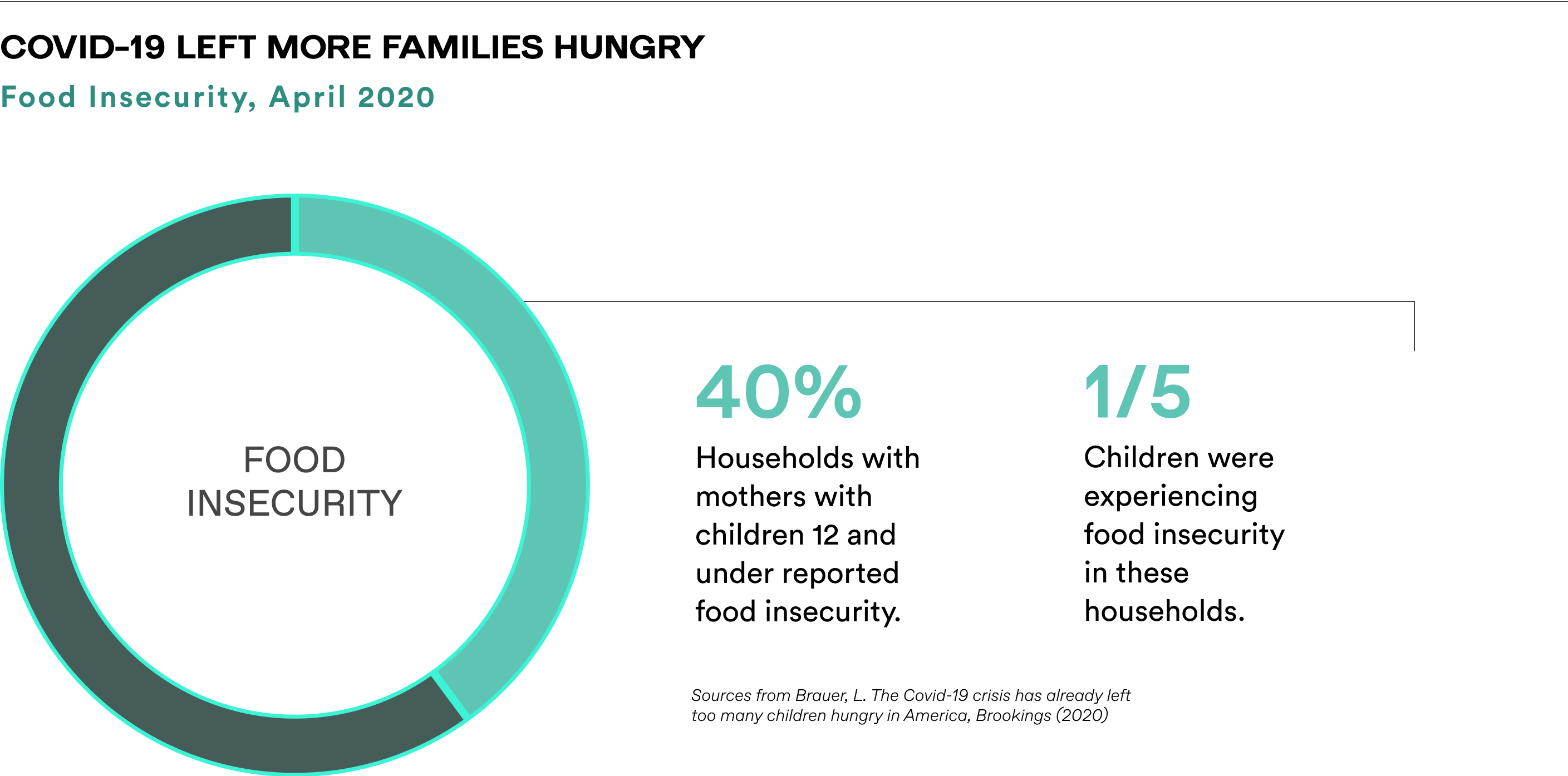
Wic remote services
and expanded food options: insights
from washington's
covid-19 response.



WIC provides nutritious foods, nutrition education, health assessments, breastfeeding promotion and support, and referrals to health and social services to low-income pregnant and postpartum women, infants, and children at nutritional risk.
From 2019–2020, Washington (WA) WIC served up to 135,000 participants, including around 42% of all infants born in the state.
“[WIC] cares about you. They care about even something like postpartum depression and they ask those questions: ‘how you're doing mom,’ ‘if you're getting help,’ ‘how the environment is at home’...‘how the kiddos are.’”
–WA Participant


Prior to the pandemic, only half of eligible individuals enrolled in WIC because of barriers such as having to be physically present at WIC offices for appointments and limited foods meeting WIC requirements. During the pandemic, the percent of people eligible for but not enrolled in WIC increased.
“I mean like we’ve seen how we’ve had national shortages on some stuff. Well, when you’re in a program like WIC, they don’t account for that. So everything is like use or lose it.”
–WA Participant
.gif)
Medicaid enrollment increased during the pandemic as more people lost jobs and employer-provided health insurance. This increase likely contributed to higher percentages of people eligible for WIC but not enrolled in WIC.

The pandemic created economic conditions that increased rates of food insecurity among vulnerable families.
“I do get food stamps but those only go so far and especially towards the end of the month, we end up running low on milk and things like that.”
–WA Participant
In March 2020, Washington (WA) State issued a “Stay Home, Stay Healthy” order and WA WIC clinics closed to the public. Congress passed the Families First Coronavirus Response Act. The Act, along
with state policy changes, increased WIC flexibilities:
• Waiving documentation requirements for ID, residency and income.
• Waiving or deferring requirements for in-person weight, height, and iron measurements.
• Waiving in-person appointments to receive benefits.
• Allowing single staff to be involved in both certification and benefits issuance for the same participant.
Using the waivers and other changes to state practices, local agencies began offering nearly all WIC appointments remotely, mostly by phone. Some sites offered video appointments or limited in-person services (e.g., pick up of WIC cards, breast pumps), mailed materials, or texted with participants.
WA WIC expanded its list of allowable foods by 600+ items (April 2020).


.gif)
Participation likely increased due to greater need for support and ease in certifying remotely.


WIC participants reported high satisfaction with remote services, describing them as convenient and comfortable.
Noted advantages of remote appointments:
• No need for childcare or to bring children.
• Saving on travel time and transportation costs
• Allowing working parents more flexibility
• Feeling safer during the pandemic
WIC staff acknowledged that remote appointments remove participation barriers, but noted concerns:
• Participants can be distracted on the phone
• Interpretation can be difficult
• Not yet comfortable with video
Staff and participants reported missing access to height, weight, and iron measurements. They also missed the social nature of in-person interaction and noted that some sensitive topics are better discussed in person.
“It was more convenient for me to do it over the phone because, with my kids, that meant I didn’t have to bring them or find a babysitter for them. I was able to just be at home and have all the information ready for it.”
–WA Participant


While redemption rates had been increasing going into 2020, the rates decreased over 10% from March to April 2020 at the start of the pandemic, likely related to the state “stay at home” order and pandemic-related food shortages. Redemption rates increased following the April 2020 food list expansion when they might have otherwise stayed low due to food shortages.
WIC participants aware of the expansion were very pleased and reported appreciating increased variety, especially given the food shortages, and more kid-friendly options.
“At the beginning, it was hard to get milk, cheese, and cereal, but then WIC updated the list of the available foods and now I am able to get them with no problem.”
–WA Participant

Staff and participants said they wanted the changes to be maintained and made some suggestions for improvements.
“I feel like once this is all over it would be nice to have a mix of both—maybe calls and in person.”
–State WIC Staff
“[Video would be] better…so we can see each other and if they have something to explain or show me they can show me over...the video.”
–WIC Participant
“One of the things that we may potentially see going forward is maybe the heights and weights being done at the WIC office, but not on the same day as the certification.”
–WIC Participant
“Just add more brands of the same item. Because it can kinda make it difficult when you’re there and trying to get certain brands and they’re all sold out cause there is just so many people on WIC.”
–WIC Participant

• Maximize participant choice and access by reducing requirements for in-person certification, and maintain remote benefits issuance.
• Pilot other ways to collect height, weight, and iron measurements (eg., at home or drop-in appointments, via data sharing).
• Fine tune remote services: develop training and support materials for video appointments, create "how to" videos for WIC EBT card and app, and translate materials into more languages
• Continue adding to the allowable food list, including more flexibility in food packaging sizes.
• Track and evaluate changes made.
“I hope we can keep doing some of these [changes]...to keep that access and equity in place.”
–State WIC Staff
University of Washington partnered with WA State Dept of Health WIC program (WA WIC) for the study.
Twelve focus groups with 52 WIC staff (10 state, 42 local) were conducted in Dec 2020 to Feb 2021. Eleven agencies were represented, including those in a mix of urban, rural, and mixed counties along with tribal areas. Local staff included WIC certifiers, nutrition educators, program coordinators, and breastfeeding educators/peer counselors.
Interviews were conducted with 40 WIC participants across 20 WIC agencies in March to April 2021. The sample of WIC participants was designed to reflect a diverse mix of populations served by WIC, based on race and ethnicity, rurality, duration of enrollment with WIC, and household enrollment. Thirty interviews were conducted in English and 10 in Spanish.
Quantitative data (2017–2021) were provided by the WA WIC.
UW study team: Jennifer J. Otten, the Food Systems Director and an Associate Professor in Nutritional Sciences and Environmental and Occupational Health Sciences, Emilee Quinn, a Research Scientist in the Department of Health Systems & Population Health, Chelsea M. Rose, Research Scientist in the Department of Epidemiology, Evelyn Morris, MPH candidate in the Nutritional Sciences Department, and Annie Vuong, Visual Communication Design undergraduate student.
WA WIC study team: Brittany Tybo, Deputy Director, Office of Nutrition Services, Cathy Franklin, WIC Improvement Project Coordinator, Jean O’Leary, WIC Nutrition Coordinator, Terri Trisler, Local Program Operations Supervisor, and Anh Tran, Research, Analysis & Evaluation Unit Supervisor.
The study team would like to thank WA WIC staff and participants who generously shared their time and experiences. This project was funded by Healthy Eating Research, a national program of the Robert Wood Johnson Foundation, through a special rapid-response research opportunity focused on COVID-19 and the federal nutrition programs, to inform decision-making regarding innovative policies and/or programs during and after the COVID-19 pandemic.
For more information visit: https://tinyurl.com/pbu6pyb8